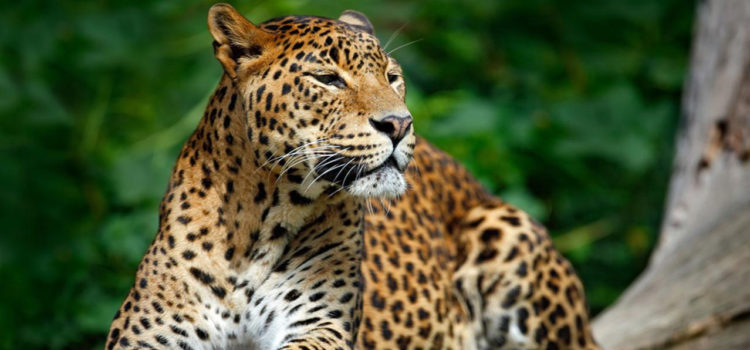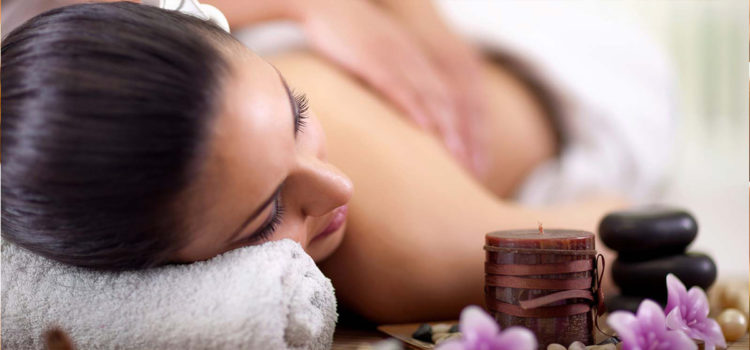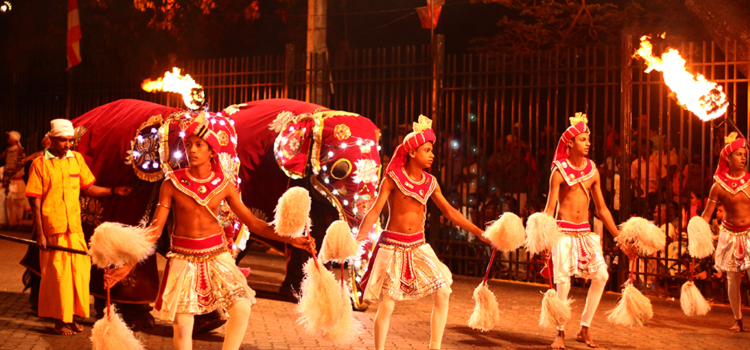Nature & Wildlife
As the sun sinks toward the distant horizon, the elephants begin to emerge from the scrub vegetation and move solemnly toward the water of a lake. It is September, towards the end of the dry season, and most water sources have long since disappeared. The Minneriya tank, however, retains water throughout the parched months and the now-exposed tank bed is flourishing, the fresh growth attracting herds of elephants from near and far.
The gentle, charismatic giants congregate here every year at this time, their numbers sometimes exceeding 300. To see so many together –playing, eating, swimming, looking for mates –is nothing but breathtaking. That this occurs very near to the physical centre of a fairly diminutive, densely-populated and compact island is symbolic of the elephant’s indigenous importance.
The crowded ecological stage
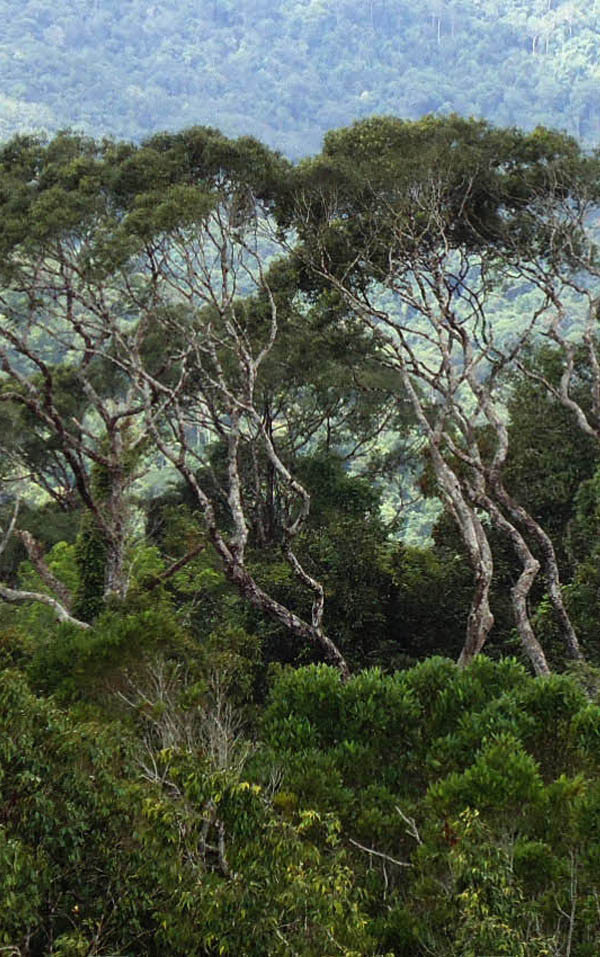
Elephants may be the most celebrated of Sri Lanka’s diverse wildlife, but they actually represent just one actor on a crowded ecological stage. For instance, this is one of the best places in the world to see the elusive leopard, and one of the only places where the big cat is top predator in the system – the king of the Sri Lankan jungle. With striking markings, a sleek, powerful body, and graceful movements, the leopard is thrilling to observe – try Yala National Park in the south-east coastal and zone.
The final member of Sri Lanka’s ‘big three’ is the sloth-bear, a shaggy, shambling denizen of the dry zone forests whose elongated snout and scimitar-like claws are ideally adapted for extracting termites from their mounds. In May and June they take to the trees – a fantastic if incongruous sight! – to feed on the sweet yellow fruits of the palu tree. Wasgamuwa National Park is one of the best places on the island to have the pleasure of a sloth-bear encounter.
As the sun sinks toward the distant horizon, the elephants begin to emerge from the scrub vegetation and move solemnly toward the water of a lake. It is September, towards the end of the dry season, and most water sources have long since disappeared. The Minneriya tank, however, retains water throughout the parched months and the now-exposed tank bed is flourishing, the fresh growth attracting herds of elephants from near and far.
The gentle, charismatic giants congregate here every year at this time, their numbers sometimes exceeding 300. To see so many together –playing, eating, swimming, looking for mates –is nothing but breathtaking. That this occurs very near to the physical centre of a fairly diminutive, densely-populated and compact island is symbolic of the elephant’s indigenous importance.
The crowded ecological stage

Elephants may be the most celebrated of Sri Lanka’s diverse wildlife, but they actually represent just one actor on a crowded ecological stage. For instance, this is one of the best places in the world to see the elusive leopard, and one of the only places where the big cat is top predator in the system – the king of the Sri Lankan jungle. With striking markings, a sleek, powerful body, and graceful movements, the leopard is thrilling to observe – try Yala National Park in the south-east coastal and zone.
The final member of Sri Lanka’s ‘big three’ is the sloth-bear, a shaggy, shambling denizen of the dry zone forests whose elongated snout and scimitar-like claws are ideally adapted for extracting termites from their mounds. In May and June they take to the trees – a fantastic if incongruous sight! – to feed on the sweet yellow fruits of the palu tree. Wasgamuwa National Park is one of the best places on the island to have the pleasure of a sloth-bear encounter.
Furry, scaled and feathered creatures
Sri Lanka’s varied forests abound with a dizzying assortment of other furry, scaled and feathered creatures. There are five species of deer, ranging from the diminutive mouse deer – just 30cm in height and armed with elongated canine teeth – to the sambar, a large, stately species in which the bull grows impressively large antlers. The latter are best seen in the high, open area surrounding Horton Plains,where they gather in the crisp evenings to feed on the long grasses – and gain protection in numbers from leopards on the stalk.
Civets, mongooses, porcupines and three species of small cats roam the forest floor, while up in the trees primates reign. The widely – spread toque macaque is an archetypal monkey – active, acrobatic and not a little mischievous in Polonnaruwa they live among the ruins of ancient temples and palaces, where the young gambol on stone walls 1,000-years old. Grey langurs, members of the tribe of the monkey-god Hanuman of the Hindu epic poem, the Ramayana, inhabit the dry lowlands and are often to be seen in large troops, pigeon-toed as they cross open ground, their long tails held partially erect in unintentional mimicry of a question-mark.
Often heard reverberating across the forested upper slopes of the central hills in the early morning is the booming call of the ‘bear’ monkey, a sub-species of the purple-faced langur, whose name derives from its shaggy bulk. The loris, smallest of the island’s primates, is also the most unusual, an enigmatic nocturnal hunter with spindly legs and large, luminous eyes. It possesses a unique, high-pitched call that pierces the stillness of the tropical night, sending shivers down the spine.
Even more evocative is the blood –curdling shriek of the Spot-bellied Forest Eagle Owl, locally known as the ulama or “devil-bird”. This is the largest and one of the rarest of Sri Lanka’s dozen owl species and part of a rich avifaunal community of 482 species that are either residents or visitors to the island, including 33 endemic species (as an island, Sri Lanka is home to numerous endemic species that evolved in isolation from mainland populations and thus developed their own distinctive characteristics).
Sri Lanka’s birdlife is astonishing, which is why ornithologists and amateur bird watchers worldwide flock here to take in such dazzling encounters as a flamboyant peacock strutting like a courtier, trying to impress the hens with his upright shimmering tail feathers, and a White-bellied Sea Eagle swooping from his perch on a half-submerged tree, diving low over an inland tank to pluck a fish from the glittering water. And not forgetting a Sri Lankan Paradise Flycatcher flitting from perch to perch its amazingly long tail feathers bobbing behind it like a chestnut ribbon.
Hornbills are seen nesting in hollowed tree trunks, completely sealed in except for a small hole sufficient only for their partners to insert food while noisy flocks of parakeets speckle the blue sky green. In Sinharaja Forest Reserve and other wet Zone forests, mixed feeding flocks feature prominently, with many species travelling together through the forest plucking insects from the air, pulling grubs from tree-trunks and sipping nectar from flowers.
On a similar scale, the island abounds with a wonderful diversity of creatures seen from the comfort of a poolside lounger or as one strolls through town. Butterflies dip and flutter on delicate wings vibrantly hued to draw attention or painted in more muted tones to deflect the same. Gaudy dragonflies hover on rigid, translucent wings while ethereal damselflies dance amid the foliage. Spiders, like tine gemstones, wait patiently in gauzy webs that shimmer, dew-drenched in the early morning sunshine.
The underwater world is kaleidoscopic array
On a breezy, tropical night, the coastline, illuminated by the light of the full moon, a small section on of a beach begins to gently quiver. Suddenly, from amid the shifting grains of sand, emerges first one, then another and another tiny black form, and their curved carapaces glinting softly.
These creatures are the leatherback sea turtle hatchlings, perfect miniature replicas of their parents, which immediately scuttle down the beach towards the sea, so beginning a remarkable battle for survival that, like the island upon whose shores they begin life, represents a perfect blend of ocean and land, water and earth.
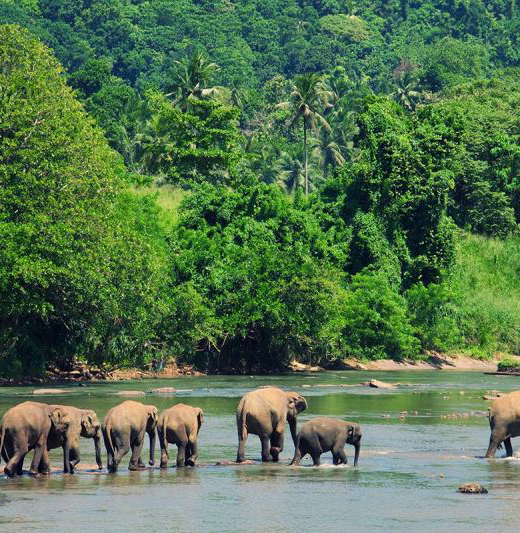
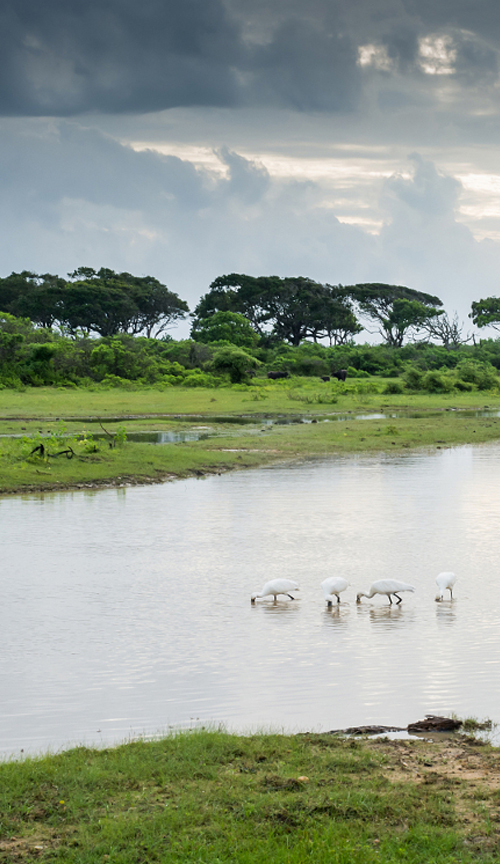
Further out from shore the wildlife diversity is no less extraordinary. The underwater world is a kaleidoscopic array of fish and coral. Electric blues, incandescent purples, radiant yellows and everything in between can be seen in deep sea caves, hovering around ancient sunken wrecks and on sheer rock walls that drop into the endless blue depths. This treasure trove of life can be visited throughout the year since the conditions are always ideal on at least one of the coasts!
Above the waterline whales breach the surface, offering tantalizing glimpses or longer, lingering views. To share into the eye of one of these mysterious, huge animals, regarding it as it regards to you, is to look back to the beginning of time. Blue whales, the largest animal on the planet, are seen off south coast Mirissa from November to May, as are Humpback and sperm whales, while on the north-west coast, off the Kalpitiya peninsula, dolphins by the score cut through the brilliant blue sea, leaping, spinning, frolicking – and even allowing lucky onlookers to share the warm waters with them.
Sand dune to cloud forest, tree frog to elephant
Sri Lanka is like a children’s story book creation: palm-fringed beaches ring a heavily-forested interior, which in turn rises majestically to form a rugged, mountainous core. Monsoon winds lash this island twice a year, the orientation and the rains they bring are responsible for determining the eco-regions that characterize the island.
Most of the broad lowland plain is the dry zone, with tall monsoonal evergreen forests composed of a canopy overarched with magnificent emergent trees. Despite the relative scarcity of water this dry zone harbours a surprisingly large complement of wildlife.
Notable among them are large mammals in the south-east and shorebirds in both regions – the latter flock here to forage in the rich tidal shallows and salty lagoons. In the south-west, the rains nurture some of the finest lowland tropical rainforest in Asia. Sinharaja Forest Reserve – a UNESCO World Heritage Site – encompasses the largest single swath of remaining lowland tropical rainforest in the country and rewards visitors with differing hiking trails alive with butterflies, birds and lizards, and rocky viewpoints offering spectacular forest vistas.

Climbing up into the central highlands, the slopes not carpeted with emerald fields of tea are instead blanketed with thick sub-montane forest that gives way to stunted montane forests above 1,500m. Waterfalls are numerous here.. Mosses, lichens and ferns – including some above head-height – proliferate here, as does an abundance of flowering plants including orchids.
One of the most remarkable aspects of this biological cornucopia – sand dune to cloud forest, tree frog to elephant – is the accessibility of it all. All ecological zones and the bounteous wildlife that inhabit in them can be comfortably experienced in a week.
There are 12 National Parks on the island and 52 Sanctuaries, which together account for over 12% of Sri Lanka’s land area, so visitors are not restricted to a few over-visited locations. For an island of such modest size, Sri Lanka is blessed with a truly startling diversity of forests and wildlife. This ecological jewel is a nature lover’s paradise that offers truly a wonderful experience.
Aurveda In Sri Lanka
Sri Lanka has always been a place that refreshes not just the mind and body, but also the soul and spirit. And for thousands of years, the most popular method used to restore and rejuvenate tired bodies and weary souls has been Ayurveda- the oldest and most holistic medical system available in the world. Based on indigenous native and Indian medicine, it draws not only on a deep understanding of physiology, but also elements of philosophy, psychology and spirituality. It was so influential that traditional Tibetan Chinese medicine and Greek medicine embraced many of the concepts introduced by Ayurveda.
According to legends in the 6th century BC, the Prince Vijaya was banished from his Indian kingdom, sailed to Sri Lanka and become the island’s main ruler. He was skilled in the practice of Ayurveda and so, together with his personal physician, introduced the practice of Ayurveda to the island. Over the years, Ayurveda incorporated elements from similar indigenous Sri Lankan treatments to become the fusion of forms it is today.
More Ayurvedic practitioners than Western doctors
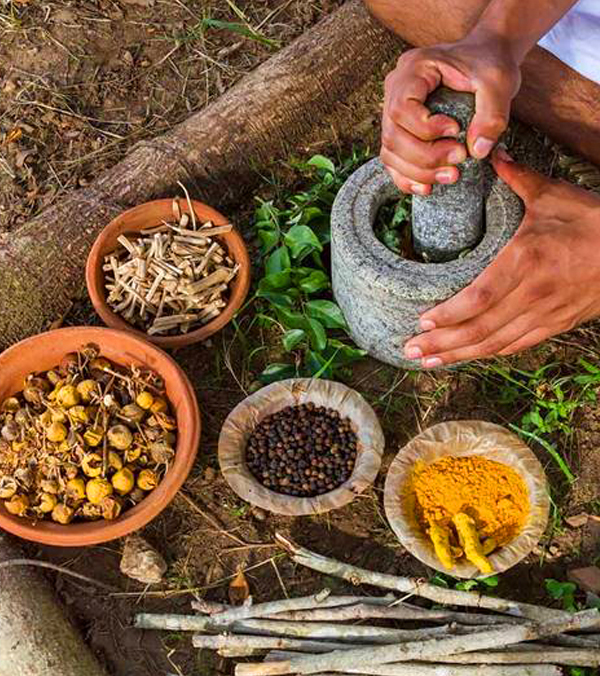
In Sri Lanka’s villages, Ayurveda is not considered a special treatment as in urban areas but an everyday method of treating aches and pains. In fact, the number of trained Ayurvedic practitioners in the island exceeds that of Western doctors.
Even those familiar with traditional spa treatments in the West (like aromatherapy and shiatsu) will find Ayurveda a new experience. And it’s an experience that’s becoming increasingly sought after. Such seekers will find Sri Lanka a singular destination, for all that collective wisdom regarding Ayurveda can be experienced in stylish and refined spas, with some of the world’s best professional therapists – with that friendly and courteous Sri Lankan manner.
Ayurveda – “The Science of Life”
The name comes from ancient Sanskrit: Ayuh or “life” and Veda or “Science”. So Ayurveda translates as “The Science of Life,” a fitting name for a system that devotes itself to a truly holistic approach to the ways the body and mind can be treated.
At the heart of Ayurveda is the theory of the Tri Dosha or “The Three Vital Forces”: Vata (wind), Pita (fire) AND Kapha(earth). In each of us is a unique combination of these forces or Doshas that help define our nature. Vata people are thin and energetic; Pita people are more intense and goal-oriented, while those with a Kapha disposition are methodical and nurturing.

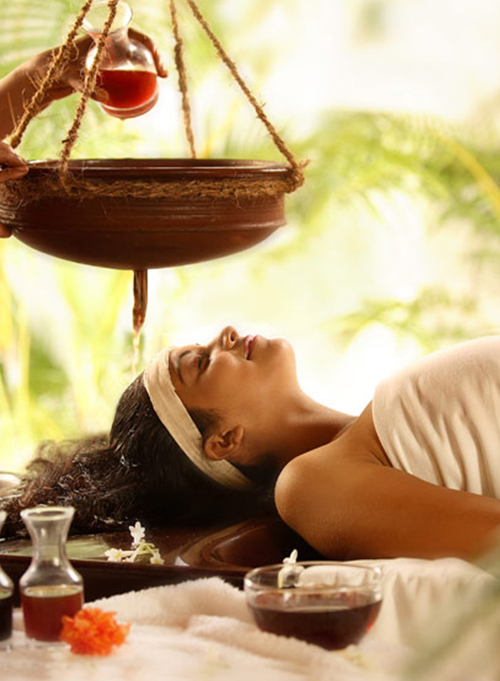
When the Doshas are in harmony the body is in good health, but when equilibrium is affected, balance needs to be restored –Ayurveda provides the answer. Ayurvedic practitioners will initially meet you with the objective of getting to the root of whatever is ailing you. Details of your diet and lifestyle, your habits (good and bad), and your general environment, will be requested. The practitioners will also carry out a physical examination and find out details of your medical history.
Practitioners employ many of the medical herbs and plants native to Sri Lanka. They combine leaves, bark, berries, roots and flowers to created bespoke potions, oils and unguents tailor-made for the individual. Incidentally, in Ayurveda there is a belief that it’s not just people but also plants that can get sick – so only “healthy” plants are used.
Swedhana, Pizhichil & Shirodhara
Inside the tranquil settings of the spa, therapists will help you decide, which of the range of therapies to adopt.
In Swedhana you are placed in, or on, a wooden chest in which herbs are boiled and the resulting steam escaping through perforations embraces your body, helping to extricate impurities.
Pizhichil is somewhat different, consisting of a relaxing massage – sometimes using two therapists – in which soothing oils are rubbed into your joints.
Another treatment is Shirodhara (“Third Eye Drip”), in which oils and other liquids are gently poured from a special vessel onto the ‘third eye’ on your forehead for 30 minutes. Profoundly relaxing, this treatment is used for conditions such as headaches and mental tension.
Later you can indulge in a flower bath, in which you lie submerged in a warm pool of blossoms, scented with fragrant flowers and sandalwood – an experience designed to reset your body as it prepares to return to the real world.
Other treatments which can be added at the discretion of your therapist include:
- Gandusha (herbal gargling)
- Akshitarpana (eye-care)
- Karnapurna (ear-care)
- Shirovasthi (head oil treatment)
- Kativasthi (back oil treatment)
Classification of food
Since Ayurveda is concerned with treating the inside as well as the outside of the human body, you can also try Sri Lanka’s delicious foods prepared in an Ayurvedic manner, which are grown in the field, freshly harvested, and prepared using authentic herbs and spices sourced locally.
In Ayurveda, food is classified into six taste categories: sweet, sour, salty, bitter, pungent and astringent.
Ayurvedic philosophy recommends you have these categories in every meal to achieve the proper nutritional balance. As important as the right mix of ingredients is the proportions: over-eating or eating before the previous meal has been digested is liable to cause an imbalance in the Doshas. Eating in moderation and at the correct time is central to the proper fulfillment of an Ayurvedic diet.
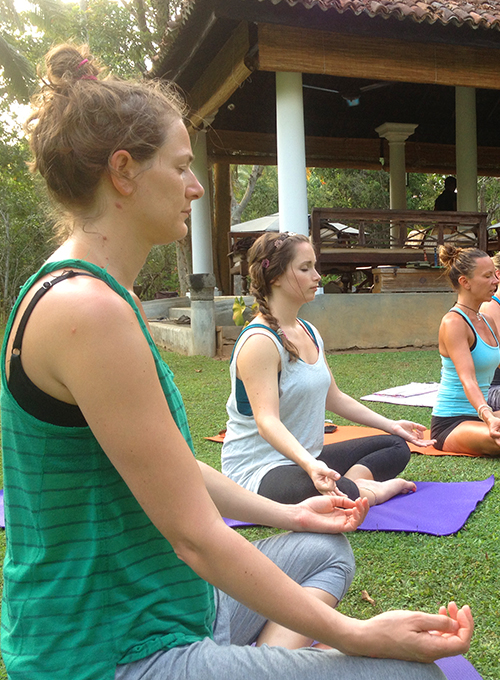
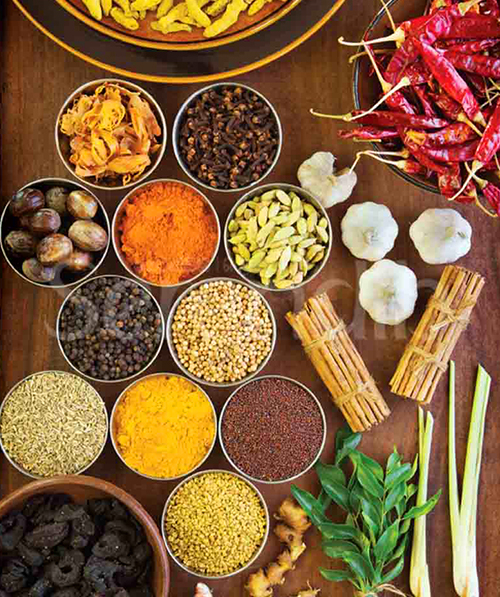
Useful on day-to-day basis learning about various methods – nutritional, physical or spiritual – you can take home and adopt in your everyday life. After all, it would not be true to the holistic nature of Ayurveda if the benefits were to stop after your holiday ended.
Before your return, why not purchase some Ayurvedic products?
Uduwarthana powder contains white sandalwood, turmeric and venivil leaves: when blended with milk it makes an excellent facial treatment.
Ksharabala, on the other hand, is oil used for treating nervous disorders from the entire babilaplant and over 40 additional medicinal herbs.
Many Sri Lankan Ayurvedic centres offer complementary therapies, such as yoga, reflexology and meditation, under the tuition of highly trained therapists. This will enable you to put together a bespoke treatment course. So a visit to an Ayurvedic spa may not just allow you to leave Sri Lanka feeling healthy and relaxed – but spiritually rejuvenated as well – truly a wonderful experience indeed.
What’s more, you can enjoy the pleasures of an Ayurvedic spa in some of the most tranquil and serene settings in Sri Lanka – on a golden south coast beach, near the ancient city of Polonnaruwa, the verdant hill country of Kandy, and even in a traditional village setting with no electricity, and mud huts for accommodation.
When you finally emerge from such exotic settings feeling refreshed and uplifted, you’ll understand you’ve learnt something truly profound through your experience with The Science of Life.
Festivals
Sri Lanka’s ancient civilization endows with a legacy of colourful festivals relating to the Buddhist, Hindu, Muslim and Christian religions. Hardly a month goes by without a unique celebration rooted in the island’s tradition. Furthermore, these festivals are commemorated with the flair of people with a genius for pageantry and ritual.
January
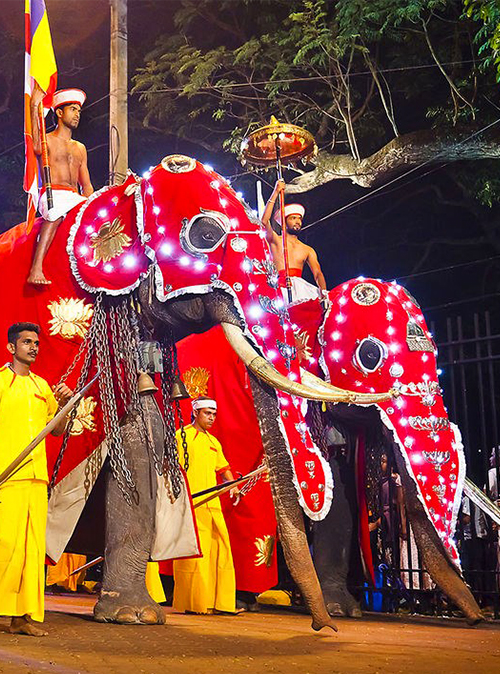
Every full moon day in Sri Lanka is known as Poya a Buddhist public holiday in which adherents dress in white to visit the temple from dawn until dusk to pray, meditate and listen to religious discourse. The 12 Poya days each year are individually named and connected to the events of the life of the Buddha and Buddhism.Duruthu Poya, the initial full moon day of the Gregorian calendar, commemorates the Buddha’s first three visits to Sri Lanka. The Kelaniya Raja Maha Viharaya or Kelaniya Temple, near Colombo, hosts a perahera, literally “procession”, to mark this symbolic event. The perahera is a spectacular aspect of Sri Lanka’s festivals in which an array of traditionally-attired dancers, drummers, whip-crackers, acrobats and enrobed elephants, participate.
For foreign visitors it’s one of Sri Lanka’s most appealing cultural attractions.
Thai Pongal, the Hindu harvest festival, is celebrated on January 14 in Hindu homes and temples throughout the country. Worship at the kovil (Hindu temple) is mandatory for adherents to the faith. Special rituals such as the cooking and ceremonial consumption of traditional sweetened rice called pongal are held at home . An observance of creative nature, kolam, involves making intricate floor motifs with flour. In rural areas, a sequel known as Madu Pongal follows. Domestic animals are washed and fed, auspicious red colour smeared on their foreheads, and finally they are garlanded with marigolds.
Colombo’s grandest open-air art festival, Kala Pola, is held on the third Sunday of January at the exhibition grounds of the Viharamahadevi Park in Colombo. Sri Lankan artists and sculptors from all over the island are given a chance to display their creative exhibits in a convivial atmosphere filled with music.
The end of January is home to the very popular Galle Literary Festival. This is a special four-day event that welcomes world-class writers and audiences from all around the world. Visitors can take part in and witness a host of talks, workshops and literary events at venues in and around this heritage city—Galle.
February – March
Independence Day, celebrating independence from Great Britain in 1948, falls on February 4. For the celebration Parades, dances, processions and national games are organized all over the island. But the main event is held in Colombo, attended mostly by political and administrative officials.
Started in 1979, the Gangaramaya Navam Perahera has since developed into one of Sri Lanka’s finest Perahera . Held at night on Navam Poya at the Gangaramaya Vihara in the heart of Colombo, it’s a popular tourist attraction.The perahera can be viewed from stands located along the roadside of the procession’s route. The fascinating preparations, particularly the arrival of over 100 tame elephants at Viharamahadevi Park, can also be observed.

The Hindu festival of Maha Sivarathri, “The Great Night of Shiva”, is celebrated in late February or early March in Hindu homes and temples across the country. This is the most important religious festival of the year for Shaivites, who comprise the majority of Sri Lanka’s Hindus. It is a deeply symbolic occasion celebrating the charming of Lord Shiva by his consort Parvati through penance. Poojas are held at kovils during the day and can be witnessed by visitors.
April

Sri Lankan New Year, which occurs usually on the 13th and 14th of April, is a non-religious festival celebrated by both Sinhalese and Tamil people in Sri Lanka. Originally a harvest thanksgiving, it does not begin at midnight on the designated day, because, like many events in Sri Lanka, the precise (‘auspicious’) timings are decided upon astrologically.
It’s believed New Year commences not when the old one ends, but a few hours later. The interval between the old and the new is called nonagathe, or “neutral period”, during which all activities cease. When the New Year commences, fresh activities begin: a fire is lit for cooking and new clothes are worn. Then comes the ganu-denu, or “give and take” in which money is exchanged.
The festival culminates when oil is mixed with herbal paste and a respected elder anoints the head of each family member.
During the festive period traditional games, both indoor and outdoor, such as kotta pora (pillow fighting) and havari hengima (hiding the wig) are played at homes and villages. The festival and its rituals help to bring families and communities together.
May
The most important Buddhist full moon day is in May – Vesak Poya – which marks the Buddha’s birth, enlightenment and passing away (Pariniwana). Large pandals (bamboo frameworks) hung with pictures depicting events in the life of the Buddha are erected in the streets, illuminated by flashing coloured light bulbs. Roadside dansalas (stalls) offering free food and soft drinks to passers-by are notable features of the event. Among the many striking Vesak decorations are intricate paper lanterns of different shapes and sizes, and little clay coconut oil lamps (pol-thel pahana) that flicker throughout the island. Visitors to Sri Lanka at this time will not fail to witness and be moved by the beautiful displays of lanterns outside every Buddhist home, business and temple.
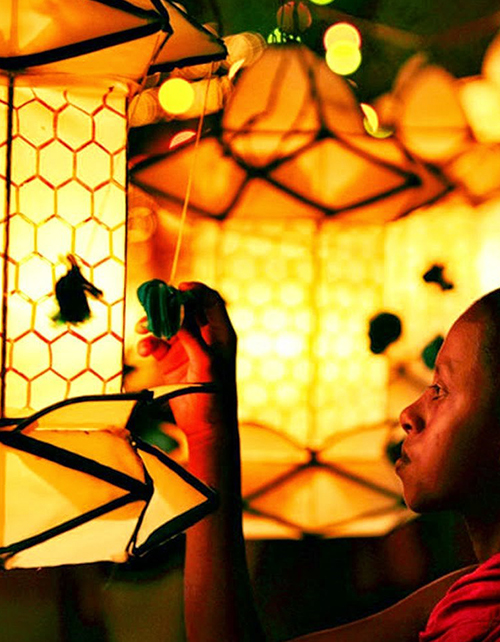
June
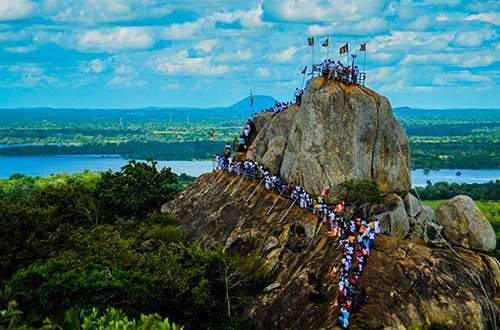
Poson Poya is second in importance to Vesak since it commemorates the introduction of Buddhism to Sri Lanka in 247BC. The focus of this festival is the ancient capital of the country. Anuradhapura, and the mountainous Mihintale Temple, reached by 1,840 steps. During Poson, the mountain is illuminated and devotees climb steps in their thousands to pay homage to the event.
July – August
Sri Lanka’s most prominent religious festival is the magnificent Kandy Esala Perahera.It is held in the hill capital of Kandy over 10 days in late July to early August and climaxing on Esala Poya.
The perahera’s origins date back to the third century BC, but the modern event originated in the mid – 18th century.
Today, thousands – including many visitors – flock to Kandy during this dazzling ten day festival, where,
the Maligawa Tusker carries the gold casket containing the relic accompanied by fellow elephants, human dancers ,touch bearers ,whippers etc.

Sri Lanka’s most prominent religious festival is the magnificent Kandy Esala Perahera.It is held in the hill capital of Kandy over 10 days in late July to early August and climaxing on Esala Poya.
The perahera’s origins date back to the third century BC, but the modern event originated in the mid – 18th century.
Today, thousands – including many visitors – flock to Kandy during this dazzling ten day festival, where,
the Maligawa Tusker carries the gold casket containing the relic accompanied by fellow elephants, human dancers ,touch bearers ,whippers etc.
The air is filled with the pulsating throb of a multitude of drums, the ethereal-sounding wail of wind instruments, the wicked crack of whips, even the occasional trumpeting of an elephant. There is quieter participation too, from stilt walkers, acrobats, and the most aesthetically pleasing and traditionally important of all the performers, the dancers.
In the southeast of the island, the sacred site of Kataragama is brought to life with its unique annual Esala Festival,
The festival commemorates the victory the six-faced, 12-armed Hindu war god, Skanda.
Naturally, many Hindu devotees make the pilgrimage to the shrine, but Buddhists, Muslims and some Christians also honour this god. During this 10-day festival pilgrims demonstrate their sincerity by performing astonishing acts of penance and self-motivation. These include walking barefoot atop hot coals and spearing themselves with hooks.
At Dondra, Sri Lanka’s southernmost point, just five kilometers from Matara, a notable festival dedicated to Lord Vishnu featuring low-country dances, traditional rituals, a perahera and a handicrafts fair, is held in July. During the same month and commencing on the Easala Poya Day is a seven-day festival with a perahera in Unawatuna, near Galle, where devotees descend on the village and beach. At Bellanwila, just south of Colombo, another perahera takes place during the week-long poya festivities held at the historic Rajamaha Vihara.
Hindus celebrate a festival known as Vel in July to mark the triumph of Lord Murugan (another aspect of the war god Skanda) over evil powers. A magnificent silver-plated chariot bearing a statue of Lord Murugan leaves a kovil in the Pettah, a commercial district of Colombo, and is lead by procession to another kovil in Bambalapitiya, followed by musicians and devotees smashing coconuts and singing songs of praise to Lord Shiva. Along the route there are stalls selling sweet delicacies, souvenirs and handicrafts to passers-by.
The Munneswaram Temple, three kilometers from Chillaw, is another focus of celebration for Hindus in July as they celebrate with fire-walking in devotion to Lord Shiva while another small festival is held at the seaside shrine of Udappuwa.
The Nallur Festival in Jaffna in August is the island’s longest festival. Spanning 25 days of vibrant chariot processions, drumming, dancing and acts of self-mortification, held in honour of the war god Skanda.
The Festivities on the Beach are a rare occasion where a blend of music, art performances, kite festivals, surfing, beach parties, weddings and leisure activities take place. The magical experience on the beach will lift your spirits becoming a feast for your eyes ! come, and explore the wonder !
October – November

The Hindu festival Deepavali, the Festival of Lights, (known in India and elsewhere as Diwali) celebrates an aspect of the epic poem Ramayana – the homecoming of the Indian prince Rama,after a 14-year exile in the forest and his victory over Lanka’s King Ravana.
In the legend, the people welcomed Rama by lighting rows of lamps, and that’s exactly what is done today. Devotees all over the country wear new clothes and cook sweet dishes to propitiate the goddess of wealth, Lakshmi, who is also associated with the festival.
December
December brings the Sri Pada (Adam’s Peak) pilgrimage season.
Buddhist, Hindu, Muslim and Christian pilgrims climb the 2,234m mountain to a temple that bears the ‘footprint’ of the Buddha, Lord Shiva or Adam, according to the different religious beliefs. This is yet another example of how the different faiths in Sri Lanka share sacred sites and symbols harmoniously.
The climb begins from the village of Dalhousie shortly after midnight in order to reach the summit by sunrise, when a spectacular triangular shadow of the peak, known as the ira-sevaya or “service of the sun,” foreshortens in spectacular fashion.
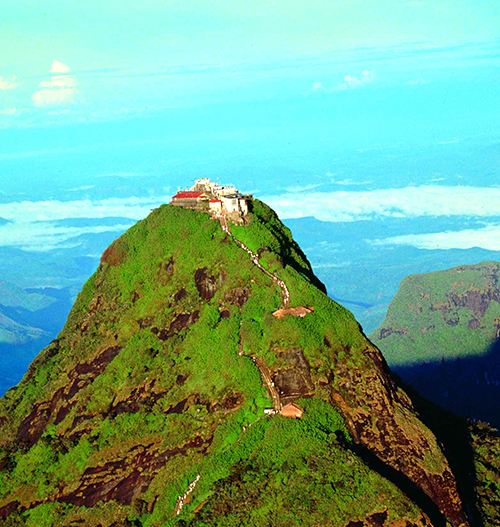
Uduwap Poya marks the planting of a sapling of the bo-tree — sri maha Bodiya – under which the Buddha gained enlightenment. Today it is one of the most sacred relics of Sri Lanka’s Buddhists and is considered to be the oldest documented living tree in the world. Devotees flock here to pray and to perform other religious rituals.
Muslim Festivals
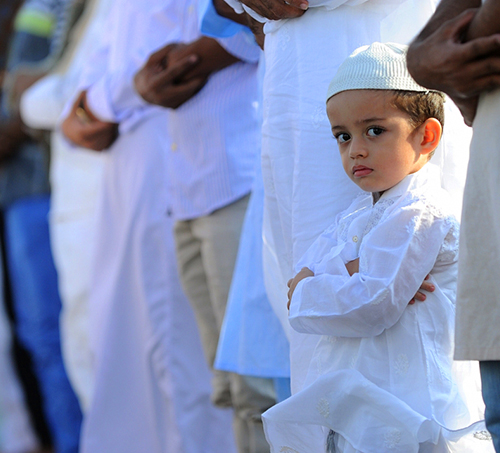
Muslim festivals follow the Islamic lunar calendar. Having either 354 or 355 days in a year, the lunar calendar is shorter than the typical solar/ Gregorian calendar. This means that Islamic holy days retreat at a rate of between10 and12 days each successive solar year, and therefore have no fixed day. Each Muslim celebration typically includes prayers and sermons at the mosque, the distribution of alms and family-orientated celebrations. Muslim festivals are typically held without much public display and with little involvement outside of the Muslim community.
The most important festivals in Sri Lanka are:
- Milad Un Nabi or Prophet Mohammed’s birthday,
- Id Ul Fitr or the end of Ramadan,
- Id Ul Alha or the Hajj Festival day.
At Milad Un Nabi, Muslims celebrate the birth of the most important Prophet in Islam by listening to speeches about his life and his teachings.
Id Ul Fitr marks the end of Ramadan, the holy month of fasting, with festivities that often go on for three days.
The celebrations surrounding Id Ul Alha, a festival to commemorate Abraham’s willingness to sacrifice his son Ismail as an act of obedience to God, often go on for four days. During Id, Muslims recite special prayers, exchange gifts between families and friends and prepare special meat dishes that are shared with the poorer Muslim community.

